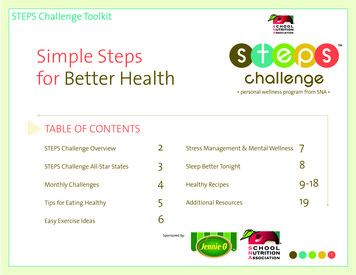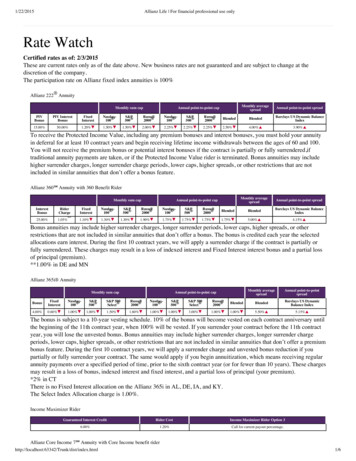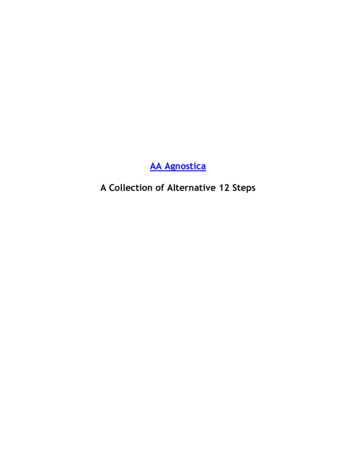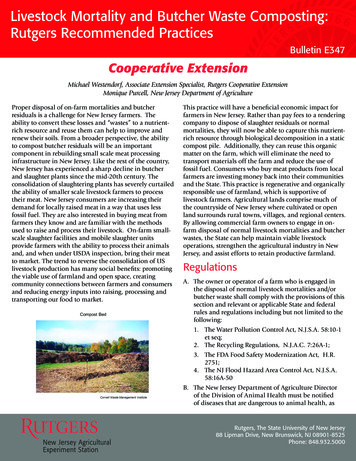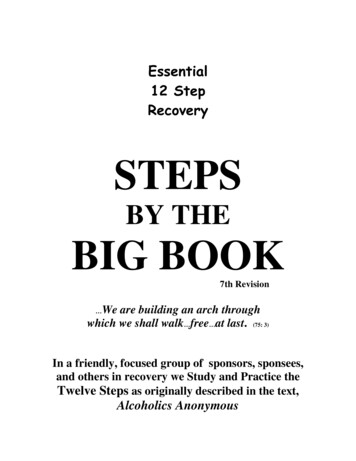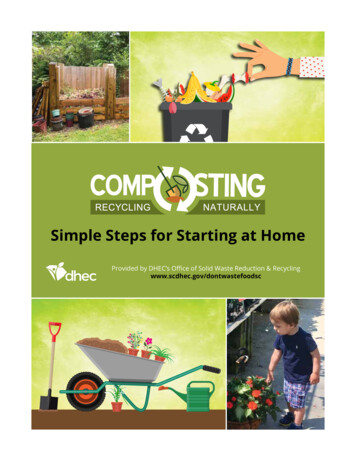
Transcription
Simple Steps for Starting at HomeProvided by DHEC’s Office of Solid Waste Reduction & Recyclingwww.scdhec.gov/dontwastefoodsc
Composting is nature’s wayto recycle.Composting happens. It’s simply the slow, natural decomposition oforganics.Composting at home is the controlled and faster decomposition oforganics such as yard trimmings and food waste that you and yourfamily generate. Microorganisms break down this material into compost– a nutrient-rich product that can be used as a soil amendment in yards,gardens, flower beds and potted plants.Why compost at home? It’s good for you and the environment.The product you make is valuable. It can improve the soil, preventerosion, reduce the use of fertilizer and water – saving naturalresources and money – as well as decrease the amount of waste yougenerate. It involves little effort, equipment, expense andexpertise.This guide addresses several home composting options and will helpyou decide which one is best for you. Backyard composting is themost common choice and the focus of this publication.Table ofContentsWhat type ofcomposting worksbest for me?. 3BackyardComposting. 4Do-It-Yourself Bins.4Bins to Buy.5Open Composting.5Backyard CompostingStep-By-Step.6What goes in yourbackyard compost?.7TemperatureCheck.8Common Problems& Simple Solutions.8When is my compostready to use?.9Other Methodsof Composting& Diversion. 10You can reduce foodwaste at home. 12Resources & ContactInformation. 12Let’s get started.Consider the following questions when planningto compost at home. Use the flow chart on thefollowing page to help you decide which method touse.1. How much space do you haveat home?2. What material will you becomposting?3. How much time and effort canyou give to this project?2Composting: Recycling Naturally – Simple Steps for Starting at Home
What type of composting works best for me?START HERECan you compost at home?Where?YesCommercialHaulerNoPage 11OutsideHow do you feelabout worms?InsideIck!BokashiPage 11What willyou compost?Food wasteonlyPage 10Got leaves?Food waste& yard mix(Or paper or straw?)YesWant supersimple?Just leavesWorm BinGreen ConePage 10NoPiles & HeapsYes, K.I.S.S.!Page 5Not that simplePile or BinPage 5Compost INthe garden?Tumbler orRolling BinNoSureSheet Mulching/Lasagna GardeningPage 5Can you dig it?Page 5No, let’s have aYes“compost area”Circular orEnclosed Bin fun?Worriedabout pests?Page 5What’s your style?Page 5Fan Favorite!Shabby chicVeryYesPits & TrenchesWoodenor Pallet Bin*Page 4Not reallySpend ?YES!DIY?NoFree is goodSubstantialElegantMinimalist(AKA easy inexpensive)Brick Bin*ADAPTEDFROMgardensthatmatter.comWire Bin*Page 4Composting: Recycling Naturally – Simple Steps for Starting at HomePage 4Cinder BlockBin*Page 4*Triple these to makea 3-section system.3
Backyard Composting OptionsDo-It-Yourself BinsTYPEBricksPROS & CONSSUGGESTIONS & PRECAUTIONSPros: Long-lasting, neat appearance, Layer bricks to leave spaces forinexpensive if reusing material, can aeration.add material during process.Cons: Time consuming to build,expensive if using new material,cannot be moved.CinderBlocksPros: Long-lasting, holes provideaeration without having to turnmaterial as often, inexpensive forreused or new material, can addmaterial during process.Brick BinMortar may not be required ifstacked evenly. You should need 20or less standard cinder blocks for abin 3 feet square.Cons: Cannot be moved.WirePros: Simple to build, inexpensiveCut an opening in the wire towardsfor reused or new material, can add the bottom to remove finishedmaterial during the process.compost.Cons: Temperature may not stayas hot.Woodenor PalletsPros: Inexpensive if reusingmaterial.Cons: Will have to be replacedeventually due to decomposition ofthe wood.ThreeSectionsUntreated wood is preferred. Checkwith local stores to see if they willdonate used pallets. Using chickenwire in combination with the woodwill help hold materials in the bin.Pros: Reduces decomposition timefrom months to weeks, providesstorage for finished compost, canproduce higher volume of materialat varied intervals, can add materialduring process.Fill the first bin with material. Whenit’s full, turn the contents into thesecond bin. Begin filling the first binagain while continuing the processof moving the material from thesecond to the third bin. When thematerial in the third bin is ready,Cons: Time consuming to build,more manual labor to turn material. remove the finished compost andbegin the process again.DIY Wire BinCinder Block BinWire BinSHOPPING LIST 4-ft. metal poles (4) zip ties (12 ) chicken wire (12 ft.) metal clips (3 )Wooden BinSTEP 1:Use a hammer to drivemetal posts or rebar intothe ground. Space the postsabout 3 feet apart.4STEP 2:Use about 12 feet of chickenwire to wrap around theoutside of the posts. Attachwire to posts with zip ties.STEP 3:Leave one end detached sothe bin can be opened to turnthe pile. Use metal clips toclose the open end.Three-Section BinComposting: Recycling Naturally – Simple Steps for Starting at Home
Bins to BuyTYPEPROS & CONSCircularBinsPros: Lightweight, adjustable, can add material during process.EnclosedBinsPros: Neat appearance, low cost, low maintenance, good barrier to pets/pests.Cons: Minimal barrier to pets/pests.Cons: Slower decomposition time, cannot add material once full, limitedspace for material.RollingBins orBarrelsCircular BinPros: Can be moved for loading and emptying or for out-of-sight storage,low maintenance, less manual labor, faster decomposition time, goodbarrier to pets/pests.Cons: Fully loaded drums can be heavy and difficult to roll, less capacityfor material.TumblersPros: Simple loading and emptying, low maintenance, less manual labor,good barrier to pets/pests.Cons: Fully loaded drums can be heavy and difficult to turn, less capacityfor material.Enclosed BinOpen CompostingTYPEPilesPROS & CONSPros: Minimal labor, can addmaterial during process, lowmaintenance.SUGGESTIONS & PRECAUTIONSWhen adding material, mix well andcover with browns.TumblersCons: Slower decomposition, nobarrier to pets/pests.Pits orTrenchesPros: Minimal labor, no brownsrequired, low maintenance.Fully cover greens and bury wherepets will not dig.Cons: Slower decomposition, newholes/trenches required for newmaterial.SheetPros: No moving compost toMulchinggarden, low maintenance.or LasagnaGardening Cons: Wait time for planting, nobarrier to pets/pests.Overlap cardboard or wetnewspaper for the weed barrier andplant directly into the top layers.Pit CompostingCollecting Your Household Food WasteA container with a lid is a great way to store food waste in the kitchenuntil you are ready to take it outside. To avoid odors and flies, empty thecontainer at least every two days, sprinkle sawdust on top of food layersor store your food waste in the freezer.Composting: Recycling Naturally – Simple Steps for Starting at Home5
Backyard Composting Step-By-StepOnce you’ve decided which backyard option you’ll be using, follow these steps.14Size matters.Three square feet is ideal fora pile or bin, but don’t exceed5 square feet. The spotshould be level and at least2 feet away from structures(e.g., house, fence, trees).Check moisture.Water is important. Toolittle moisture will inhibit thecomposting process. Toomuch moisture will cause thecompost to smell. TIP: Thecompost should be as moistas a damp sponge.25Connect to the soil.Your compost needsmicroorganisms from the soil.If using a pile or bin open tothe ground, loosen the soilabout an inch deep beforeadding material. For enclosedbins, place a layer of soil atthe bottom of the container.Mix it up.Air is essential. Use apitchfork, shovel or rollyour tumbler to turn yourcompost – preferably oncea week, but no less thantwice a month – to inhibitodor-causing bacteria and tospeed the process.36Add ingredients.Making compost is a lot likecooking a meal – you needa recipe. Alternate layers ofgreens and browns as listedbelow. TIP: Make sure thetop layer is always browns.Watch and it’s done!As material breaks down thecompost will get warm. Don’tbe alarmed if there is steam.Wait about 12 weeks. Whenyour compost has no piecesof food and is a dark, soil-likematerial, it’s ready! See pages8 and 9 for more tips.The Compost RecipeFour basic ingredients are required for backyard composting:1) browns; 2) greens; 3) air; and 4) water.Mixing the right amounts of these ingredients will provide the compostingmicroorganisms with enough carbon and nitrogen as well as oxygen andmoisture to break down the material into finished compost.Recipes vary. A common mix is three parts browns to one part greens.Other variables in making compost include pile size, content, particlesize, turning frequency, moisture and temperature. Getting the rightproportions may take time and adjustments, but don’t get bogged downon the recipe.6Composting: Recycling Naturally – Simple Steps for Starting at Home
What goes in your backyard compost?CARBON MATERIALS (Browns)NITROGEN MATERIALS (Greens)Shredded cardboardBread & grainsDryer and vacuumcleaner lintCoffee grounds& paper filtersCrushed egg shellsFruits (cooked oruncooked – limit citrus)Fireplace or wood ash (no coal ash)Hay and strawPinestraw (small amounts)Nut shellsHousehold plantsand used potting soilGreen grass clippingsGreen leavesGreen shrub pruningsHair and furHouse plantsOld brush, shrub trimmingsand pruningsKelp or seaweedPaper towels and towel rollsManure from chickens,rabbits, cows, horses (herbivores)Saw dust and wood chips(untreated)Shredded newspaperYard trimmings(dry leaves, clippings and twigs)Old flowersTea bags (with tags)Vegetables (cooked or uncooked)NOTE: Always mix food waste into the middle of the pile to avoid odors and pests.DO NOT COMPOST THESE ITEMS IN BACKYARD BINS!Coal ash from briquettesGlassPlasticDairy productsMeat, bones or seafood scrapsTreated or painted woodDiseased or infected plantsMetalTrimmings toxic to other plants (e.g.,black walnut, hemlock)Dog, cat or human wasteOils, fats, grease or lardWeeds, roots or seedsComposting: Recycling Naturally – Simple Steps for Starting at Home7
Temperature CheckTemperature is an essential component of composting. As organicmaterial decomposes, heat is produced. This heat provides anenvironment where the microorganisms can work to break downthe material. Understanding and monitoring the temperature areintegral to ensuring that you produce quality compost that is freefrom potentially harmful pathogens.Here is some basic information on temperature. A properly working compost pile will reach temperatures of130 F to 160 F. Use a compost thermometer. Temperatures should be takenfrom the center of the pile where it is hottest. Keep a record tocompare different phases based on ingredients and methods. Heat destroys pathogens and weed seeds. Most pathogensare destroyed at temperatures of 130 F to 140 F for 72 hours.Most weed seeds are destroyed at temperatures of 140 F orabove for 72 hours. Don’t overheat. Heating your pile above 170 F for more thana few hours is not recommended because it inhibits mostmicroorganisms and shuts down decomposition.Common Problems & Simple SolutionsAnytime you try something new, problems can arise. Luckily, composting is not too complicatedand most problems are simple and can be easily remedied. Here are the usual trouble spots.SYMPTOM8SITUATIONSOLUTIONThe pile has a rotten-egg smell.There is too much water.Turn the pile and add more browns ifit’s soggy.The pile has an ammonia smell.There is too much nitrogen or notenough air.Add browns and turn the pile.The pile isn’t decomposing quicklyenough or isn’t producing enoughheat.The pile is too small.Mix new ingredients into the pile.The material is too dry.Add water and turn the pile.The pile needs nitrogen.Add greens.The pile needs oxygen.Turn the pile more frequently.The pile is too hot. The temperatureis 170 F or above.There is too much nitrogen.Add browns and water, then turn thepile.The pile is losing heat before thecompost is finished.The material is going anaerobic –losing air.Add greens and turn the pile.Flies and/or gnats are around thepile.The greens are exposed.Check the material list on page 7.Cover the greens with browns.Composting: Recycling Naturally – Simple Steps for Starting at Home
When is your compostready to use?When material at the bottom has no remnants of food oryard trimmings and the pile begins to cool, your compostshould be ready to use. The temperature will begin todrop while turning the pile just before the compost iscured and ready to use. It will be the rich brown color ofgood soil and smell earthy.The nose knows.A simple smell test can bedone to see if your compost isready. Place a small amount ina plastic bag and take a whiffbefore sealing the bag. Aftera few days of storing the bagin a dark place, the sample shouldsmell the same as it did before. Ifit smells worse, your compostneeds more time to cure.Composting: Recycling Naturally – Simple Steps for Starting at HomeUses for Compost Use it as mulch. Spread2-3 inches around plants,trees, shrubs to help retainmoisture. Use it on the lawn. Apply1-3 inches of compost to yourlawn and water it into the soil.It will leave you with healthiersoil that holds water betterand keeps your grass green.Do this once a year and you’llneed less fertilizer. Use it as a soil amendment.About one month beforeplanting, apply 1-3 inches ofcompost and work it in thetop 3-4 inches of soil. Yourflowers and plants will thrive.Compost also can be used inthe garden as a top dressingor mulch. Use it with potting soil. Mix1 part compost with 2 partspotting soil.9
Other Methods ofComposting & Diversion GrasscyclingGrasscycling is the natural recycling of grass clippings byleaving them on the lawn after mowing. Grass clippingsconsist of at least 80 percent water and rapidly decompose.They enhance soil fertility – returning water, nitrogen andother valuable nutrients to the soil. You spend less timemaintaining the yard and save money by using less fertilizerand water.GrasscyclingVermicomposting Bin VermicompostingVermicomposting –composting with worms– turns food waste into anutrient-rich soil amendmentfrom worm castingsand can be used on bothhouseplants and outdoor plants.Vermicomposting is relatively easy– using only a container, bedding, worms, water and foodwaste from your home. Worm bins can be purchased oreasily made with a 3 to 12-gallon plastic storage bin. Beddingcan be shredded newspaper or leaves. The worms neededfor vermicomposting are red wigglers (Eisenia fetida),which can eat their weight in organic material per day andcan be purchased locally or online. This project is greatfor indoor composting in a minimal space and is virtuallyodorless. It typically takes three to four months to producevermicompost. Another product of vermicomposting is“worm tea” that is a high-quality liquid fertilizer. Food DigestersFood digesters – also know as Green Cone Composters –are designed to accelerate the natural decompositionprocess by raising temperatures, maintaining aerobicconditions, and encouraging the growth of microorganisms.This system processes almost all household food wasteincluding the “don’ts” like raw and cooked meat, fish, bonesand dairy. The cone has a basket installed below the ground,which forms the base for an above ground solar chamberwith a sealed access lid. The food waste is converted intowater, carbon dioxide and a small amount of residueFood Digester10Composting: Recycling Naturally – Simple Steps for Starting at Home
without the need for mixing or turning the waste. After about five years the small quantity ofresidue is removed and dug into the garden soil. BokashiBokashi is an anaerobic method developed in Japan that usesinoculated bran to ferment food waste. Food waste is brokendown quickly by microorganisms until it is pickled –producing “pre-compost” that can be mixed with soil.This method also creates a leachate that can be used ascompost tea – a nutrient-rich fertilizer. Bokashi bran andequipment are required for this method. Commercial Compost HaulersCommercial composters may have residential pick-up ordrop-off options in your area. Because the material is goingto a commercial compost site, more compostables can beincluded with food waste such as meat, bones, compostableplates and dinnerware, wax paper and spoiled leftovers.Contact your county recycling coordinator at www.scdhec.gov/recyclehereSC, or find a compost hauler in the Green ResourceIndex at www.scdhec.gov/gri.Bokashi-Style BucketVisit www.scdhec.gov/compost to learn more about these and other methods of composting.Composting: Recycling Naturally – Simple Steps for Starting at Home11
You can reduce food waste at home.Food waste is the No. 1 item thrown away by Americans– accounting for 21.6 percent (38.4 million tons) of thenation’s waste in 2014 according to the EPA.Most food waste is generated at home – much ofwhich is safe and wholesome, and could have beenconsumed.It is estimated that a family of fourthrows away about 1,500 worth offood every year.The Don’t Waste Food SC campaign provides tips onhow South Carolinians can reduce food waste at homethrough prevention, donation and composting. Do yourpart. Visit www.scdhec.gov/dontwastefoodsc to learnwhat you can do.Resources & Contact InformationDHEC’s Composting Web PageWebsite.www.scdhec.gov/compostDHEC’s Office of Solid Waste Reduction and RecyclingTelephone. posting: Recycling Naturally – Simple Steps for Starting at Home“ is a publication of DHEC’s Office of Solid Waste Reduction and Recycling.PRINTED ON RECYCLED PAPER OR-1520 6/18PRINTED2018 PaperPrinted onJUNERECYCLEDTotal Printing Cost:Total Number Printed:Cost Per Unit:PRINTED ONRECYCLEDOR-1705PAPER 5/18
Composting: Recycling Naturally – Simple Steps for Starting at Home 5 TYPE PROS & CONS Circular Bins Pros: Lightweight, adjustable, can add material during process. Cons: Minimal barrier to pets/pests. Enclosed Bins Pros: Neat appearance, low cost, low maintenance, good barrier to pets/ pests. Cons: Slower d



